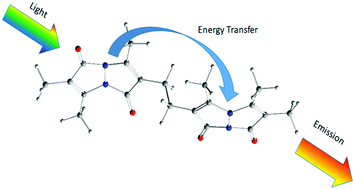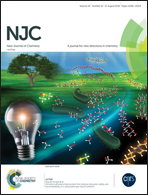Computational modelling of singlet excitation energy transfer: a DFT/TD-DFT study of the ground and excited state properties of a syn bimane dimer system using non-empirically tuned range-separated functionals†
Abstract
The ground and excited state properties of a syn (H, H) bimane dimer was investigated using correlated wave function methods such as CCSD(T), EOM-CCSD, CR-EOM-CCSD(T) and DFT/TD-DFT with various exchange–correlation functionals (CAM-B3LYP, M06-2X, M11, ωB97X and ωB97XD). The ωB97X functional with a non-empirically tuned range-separation parameter, ωB97X*, was found to be the best performer with respect to studying the vertical excitation energies and interaction energies in the syn (H, H) bimane dimer. These results were applied to model the process of excitation energy transfer within a dimethylene bridged anti, syn bisbimane molecule. The rate of energy transfer was computed to be 2.6 × 1011 s−1, close to the experimental value of 6.7 × 1011 s−1.



 Please wait while we load your content...
Please wait while we load your content...